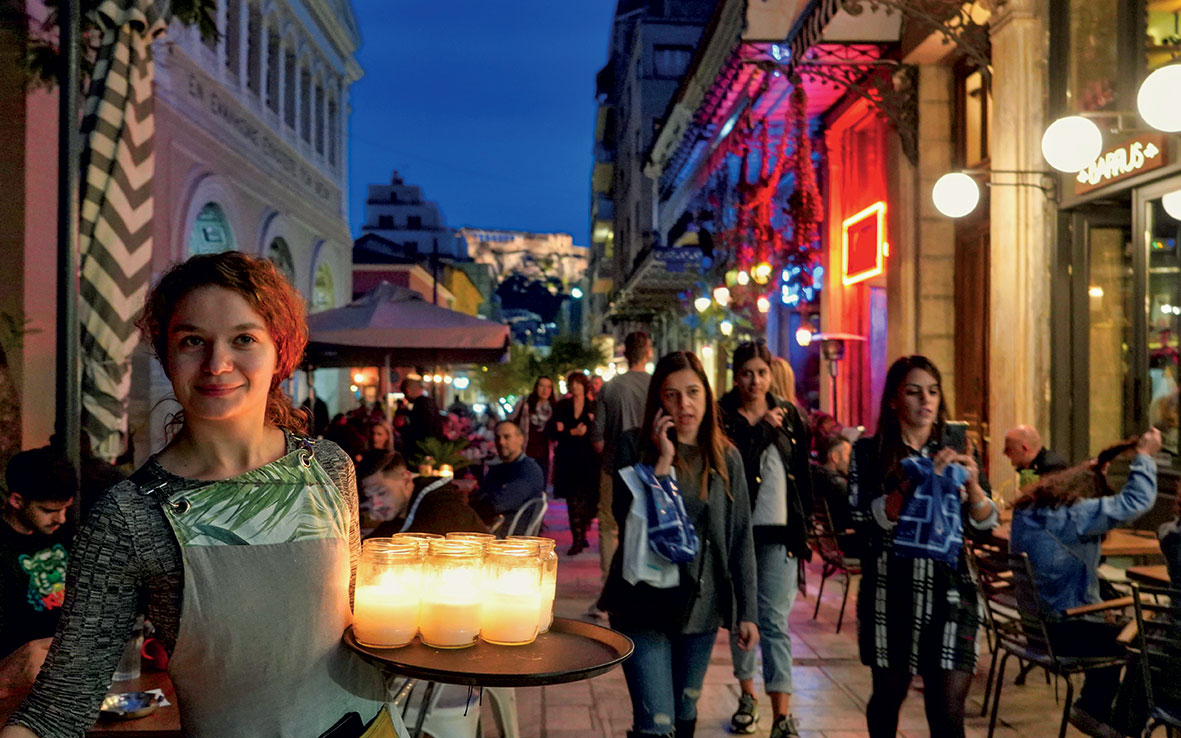There he is, just across from me. I reckon he’s about 35. Lanky, with blond hair (I bet he gets it cut by some hip barber), and clad in a dark, skinny suit. He unwraps something that looks too healthy to be tasty. He tries to get comfy on his bench on the pedestrianized street, as the sun browns his face and mopeds whiz around him, all entangled in a landscape dotted with colorful bolts of fabric standing proudly upright outside old shops. I think I see him laughing.
This is the center of Athens, a buzzing hub for people who form part of a motley mosaic coming and going from thriving commercial ventures. It is a constantly evolving scene.
Trying to find out how the district known as the Commercial Triangle of Athens changed from a place of protests, demonstrations and tear gas to a neighborhood full of life and positive energy, I leave Syntagma Square behind and walk along Karagiorgi Servias.
This little street, which at rush hour features a line of motionless cars, leads to an area crowded with shops offering furniture and door-related hardware – these businesses, known as pomoladika, sell everything from doorknobs to hinges to deadbolts.
The center of Athens was once a big open-air shopping center, with neighborhoods defined by the type of shops they had.
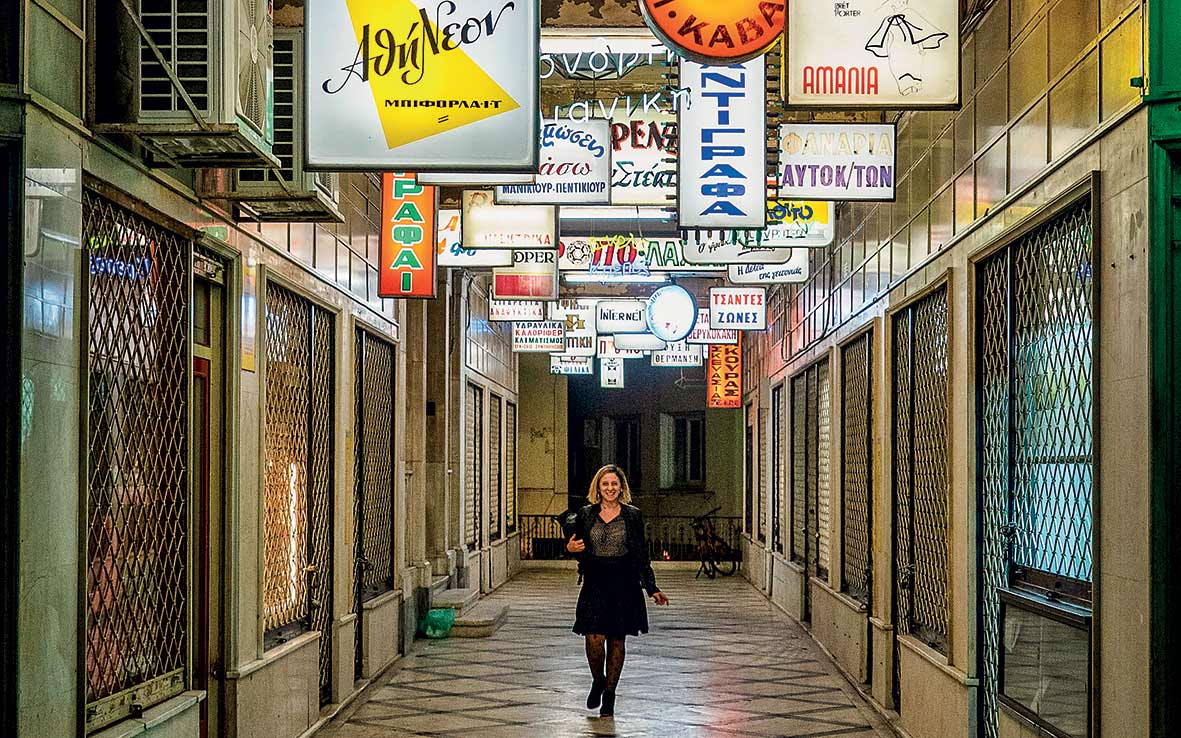
© Perikles Merakos
If you look at a map of the city, you’ll understand why it’s called a triangle; three squares – Syntagma, Omonia and Monastiraki – make up its points, while its three sides are Stadiou, Mitropoleos and Athinas streets.
If the Commercial Triangle is the heart of Athens, then Karagiorgi Servias, Ermou, Kolokotroni, Perikleous and the dozens of other small streets and even tinier lanes within it are the arteries and capillaries supplying the area with both its distinct atmosphere and some surprising contrasts.
On these streets, two-story 19th-century houses coexist with interwar apartment blocks and with large, stately buildings from the 1960s that, once used as offices and small industrial facilities, are now being converted into hotels. Fabric and linen shops stand side-by-side with smoothie bars on sidewalks littered with rental bicycles and electric scooters.
But it wasn’t always this way.
Going out onto the roof of the five-story building that houses the main offices of the Nota underwear company – one of the oldest family businesses in the city center – I’m overwhelmed by the view of the Acropolis. While walking along little Leocharous Street, which is located behind Klafthmonos Square, I’d seen nothing to prepare me for the hidden surprises that were to come just a bit higher up.
Vassilis Masselos, the company’s managing director, shows me another building which, until recently, housed the local police station; a group of workers are now busy converting it into a hotel. “Real estate values are such that, in a little while, it won’t be in our interest to stay here,” he tells me.
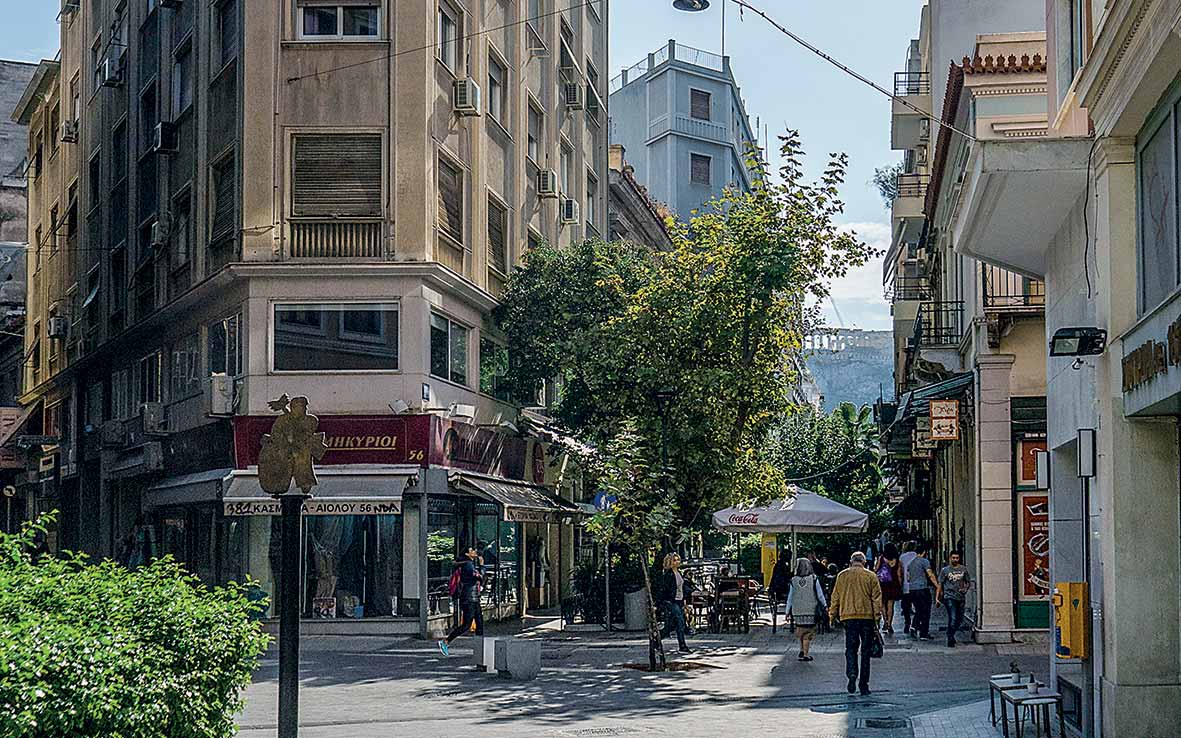
© Perikles Merakos
Masselos speaks of the Commercial Triangle, which he has known well since he was a child, with love and considerable erudition; he uses the Nash equilibrium from game theory to explain the clustering of similar businesses in the area. I learn that Praxitelous – the street below us – used to be where all of the kasmiradika (shops selling cashmere goods) were located, that the electrical appliance stores were on Klafthmonos Square, that the goldsmith and silversmith workshops were on Thiseos and Romvis streets, that the florists and plant nurseries were on Aghias Irinis Square, and that the furniture and pomoladika were on Vyssis.
“The center has always been made up of clusters of businesses offering similar products or services. It was the site of what we would call a ‘mall.’ There were about 450 businesses; it was a center of processing and manufacturing activity,” he notes.
The commercial district began to deteriorate gradually during the 1990s, as, one after another, small shops started closing down. There were few signs at first, but as Athens changed and commercial activity shifted to areas on the periphery of the center, the Triangle lost its old cottage industries and the kafeneia (traditional coffee houses) tucked away in the larger buildings.
The hosting of the 2004 Olympic Games gave the area a boost, but a sharp decline was to come a few years later. Hard times peaked in 2011-2012, when Greece had fallen deep into crisis. There were street demonstrations, riots, property damage and abandoned shops.
When talking of those days, businesspeople, professionals and residents paint a forlorn picture. Property values had plummeted, and the heavy metal doors of desolate graffiti-covered buildings stayed shut. It looked as though the lights had gone out in the center of Athens.

© Perikles Merakos
One of the larger investments – perhaps the biggest – that contributed to the transformation of the Commercial Triangle and signaled the rebirth of this area of the capital was the opening of the Electra Metropolis Athens hotel on Mitropoleos. The building, designed by the renowned architect Patroklos Karantinos, had formerly housed the Greek Ministry of Education.
Yiannis Tsakalos, director of marketing at Electra Hotels & Resorts at the time, recalls the first signs of a positive change in the area. “We announced the construction of the hotel in early 2014, and later, after we had covered up the building in order to carry out the work, we saw shops opening up, one after the other. What has happened in the center during the last few years is unique. Businesses have been created using a lot of imagination, and the Commercial Triangle has once again become a key destination for everyone.”
As for the special “Relove Athens” package offered by the hotel, through which Athenians were given the opportunity to reacquaint themselves with the revived center of their city, Tsakalos explains that the hotel “tried to bring an optimistic note to the center.”
It isn’t just the locals, however, who rediscovered the cocktails on offer in the city center, the brand name shops along Ermou, the traditional Athenian markets, the eggs Benedict dishes served up on Aiolou, and the little shops where people can get their watch straps changed or find a new lampshade for their living room.
It’s also the countless visitors who poured into the small boutique hotels and Airbnbs, breathing new life into the district and consequently driving up real estate values.
The Commercial Triangle acquired a retro chic style; the colors turned earthy, 1960s-style lettering appeared on new signs and marquees, and commercial arcades that had gone dark turned their lights back on. The Municipality of Athens created pedestrianized streets and special signage, and event organizers began staging activities on the streets and in old buildings.
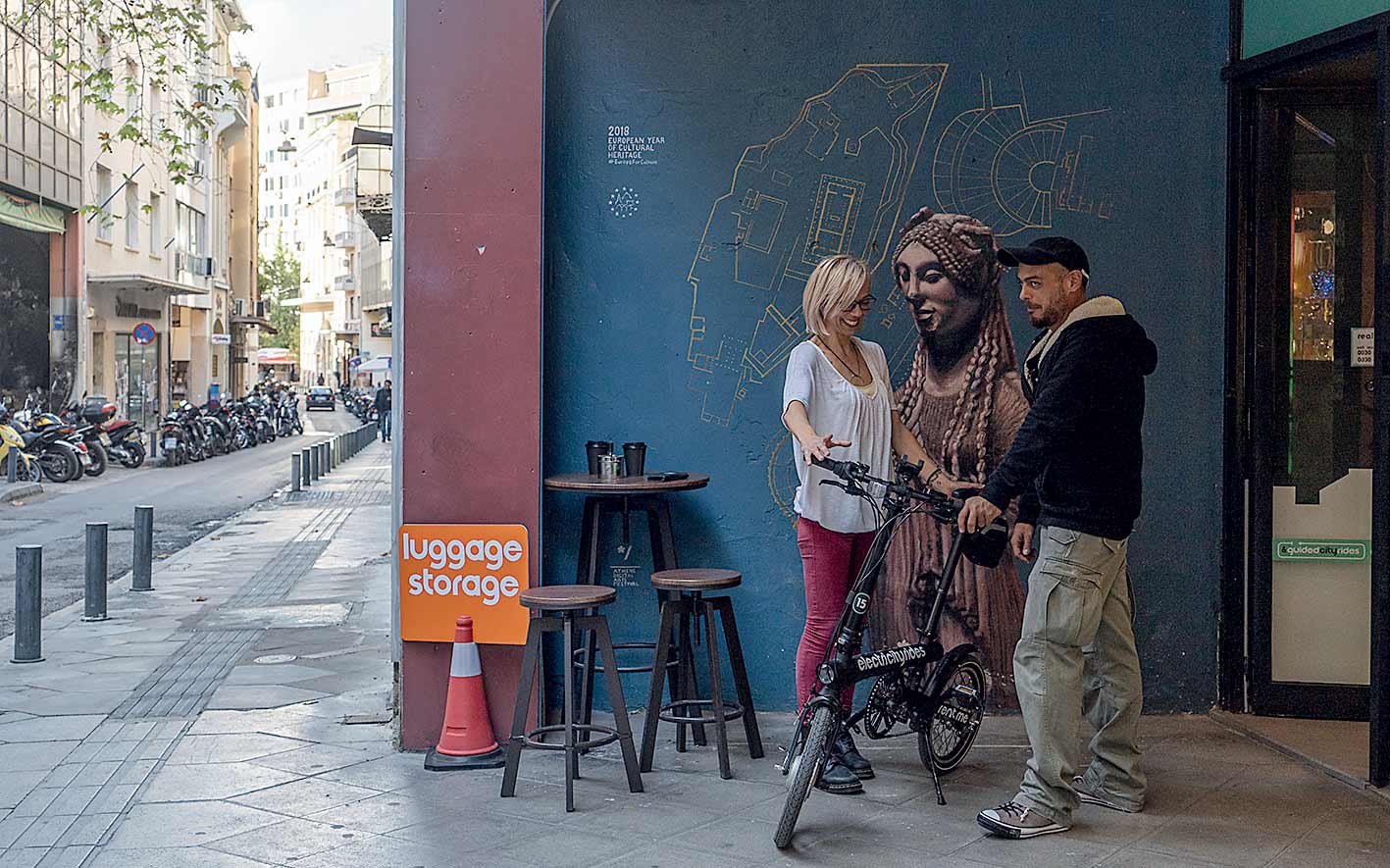
© Perikles Merakos
Today, it seems that those “crazy people,” who had invested in the center’s decayed charm have been vindicated. Among them is Panagiotis Pilafas, general manager of six d.o.g.s, the avant-garde entertainment spot that has been setting the musical tone on Avramiotou Street from the first day it opened some ten years ago.
“Those were tough times; most people avoided the center. They thought I was nuts investing here, but I thought its development was inevitable,” he tells us as we sit chatting outside in the new restaurant in the establishment’s famed courtyard.
He cites the Tribeca neighborhood in New York City as an example. It, too, was an area with offices that turned into a ghost town every evening. In just a few years, however, it was transformed into one of the most expensive and touristic areas of Manhattan. Pilafas saw the same potential in the Commercial Triangle.
“Visitors experience a scene that is less ‘sterilized’ compared to other cities,” Pilafas says, “and they enjoy the vibrant energy of the city center. This also attracts many foreign artists to Athens. However, a balance is needed, a plan to protect the small shops, otherwise the scene we see in the city center will become one of cookie-cutter replication.”
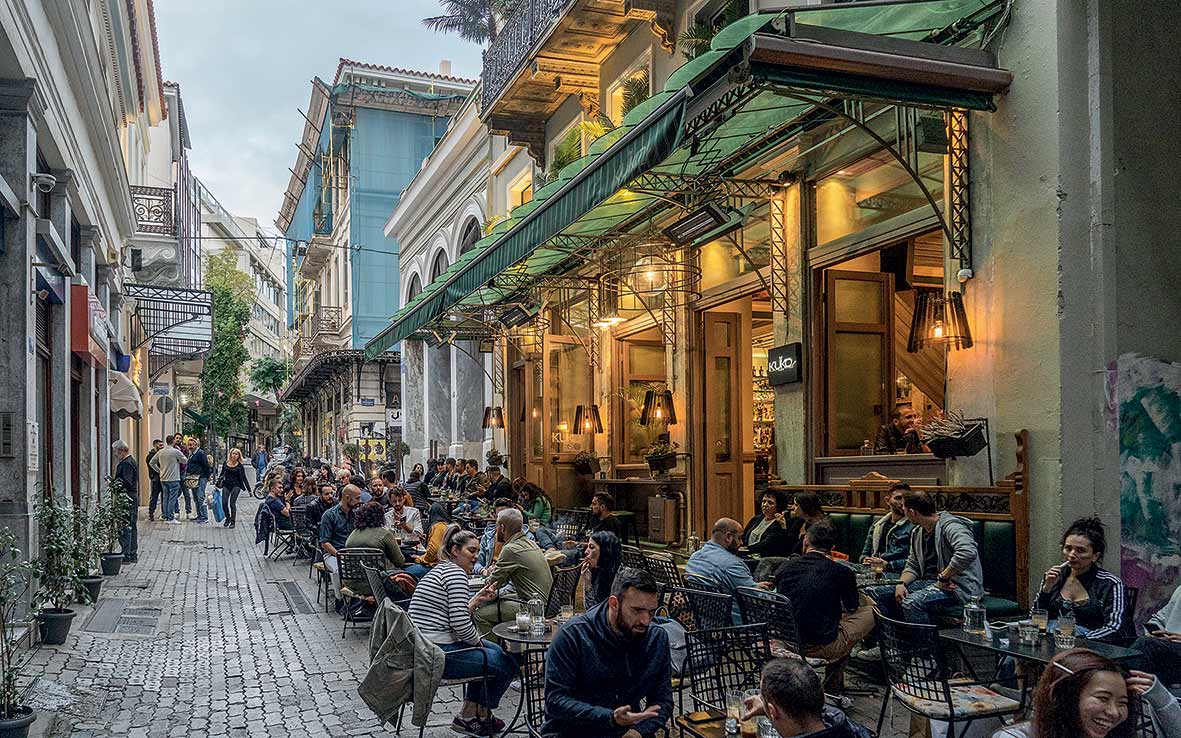
© Perikles Merakos
Photographer Kamilo Nollas, a resident of the area since 2011, also points out the need for balance. His first years here were difficult, he remembers, but then the picture changed – as did his life. He sold his motorcycle and started to move around by bicycle, as anything he needs can be found close at hand.
But in a capital city that stays up late, he sleeps with earplugs in. “The city center lends itself to living there, but there are difficulties, especially during the present period with the real estate prices and Airbnb boom. Still, every time we say we’re going to leave, we look for excuses in order to stay,” he tells us.
Others are aware of the area’s appeal as well. Despite his advanced years, Laskaris Laskaridis’ handshake is firm. He first entered the world of business in 1968, initially as an employee and later buying a little shop. “I started out without a large amount of capital, but I had a good relationship with suppliers. Conditions were different back then,” he recalls, as we sit among the hundreds of curtain rods, doorknobs and door locks that make up his shop’s inventory.
He explains that, during those early years, the construction industry in the city was thriving and builders were buying what they needed from the shops in the Commercial Triangle. This allowed him to move to a larger space, and gradually buy the eight-story building that houses his business today.
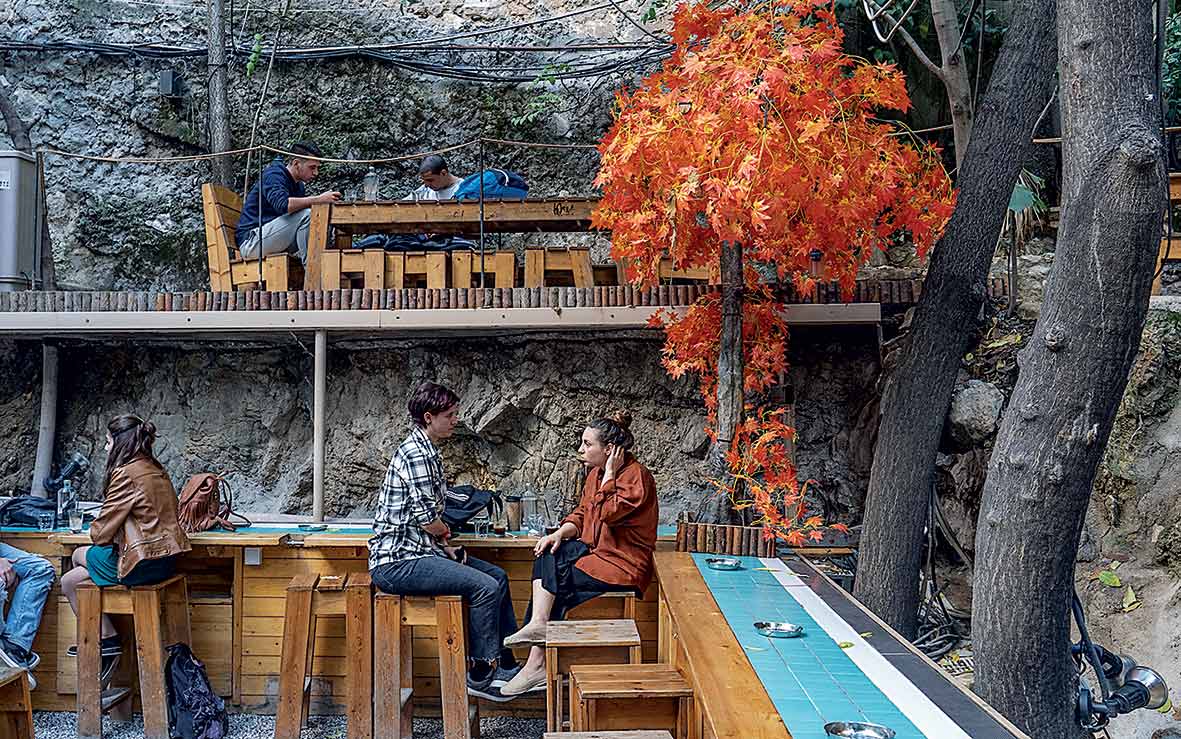
© Perikles Merakos
The spread of Airbnb and hotels in the area also brought with it the renovation of old buildings within the district, benefiting his business and others operating in his field. Despite this, he says that his industry is not doing well. “We’re in a new era, and our sector is facing difficulties. Tourists do pass by, however, as they like this concentration of shops, which they don’t find elsewhere.”
This “biodiversity” is precisely what makes the Athens Commercial Triangle special – the juxtapositions, the contrasting images, the colorful variety. If this were to disappear, the center of Athens would never be the same.
At the same time, it’s a fact of business that no one can stop change. Laskaridis, who’s well aware of this, is already at work on the building next to his shop, but he isn’t just replacing its fixtures. Instead, he’s converting it into accommodation space.

